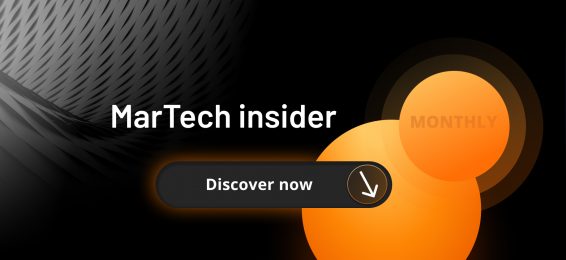Here’s a look back at October’s top MarTech and AdTech stories, along with our take on the latest industry shifts. Spotify ramped up its programmatic ad efforts with the launch of its own ad exchange, The Trade Desk refined attention metrics with high-quality placements, and brand safety saw a makeover with private marketplaces for premium news publishers. Dive in for insights into these stories and more.
Stay with us for insightful recaps, expert analyses, and strategies driving the industry forward. Follow Xenoss MarTech Insider and stay in tune with the trends that matter!
Let’s dive in!

Spotify is making significant investments in ad technology and expanding its capabilities, including programmatic advertising, with the launch of its Spotify Ad Exchange (SAX), which started testing with The Trade Desk. Spotify is testing its new ad exchange by starting with video inventory, with audio ads to follow. This approach aligns with TTD’s goal to connect advertisers directly to publishers without a third-party SSP, allowing for a streamlined, DSP-integrated experience.

This video-first approach is part of Spotify’s broader push into video, which is the fastest-growing medium for digital ad dollars, potentially positioning Spotify to capture Connected TV (CTV) ad spend alongside major platforms like YouTube. In addition to testing video inventory, Spotify is ramping up its video offerings by expanding its music video content to nearly 100 global markets, mirroring YouTube’s successful model of embedding ads between music videos. Spotify plans to roll out audio ad inventory after the current video inventory testing phase, providing a comprehensive offering for advertisers seeking programmatic access.
Spotify’s integration with Unified ID 2.0 and adoption of The Trade Desk’s OpenPath is also a key part of its shift toward self-serve programmatic offerings. By going direct to DSPs, Spotify may benefit from eliminating SSP fees—formerly through providers like Magnite and Google Ad Manager—potentially boosting sell-through rates and CPMs. This move also supports Spotify’s recent move towards more efficient programmatic monetization, following reductions in ad sales staff. TTD’s role as the exclusive initial DSP for SAX represents a broader trend of top-tier publishers joining TTD’s “Premium Internet” ecosystem.

ProNews Collective pushes back against brand safety tools
Publishers are ditching blunt brand safety tools by forming private marketplaces of marquee news sites. Prohaska Consulting‘ new ProNews Collective aims to help buyers combine scale with safety, shifting ad dollars back to the news. It’s not an ad network—just fewer tech layers, more revenue, and a fresh approach.

Zeta Global completed the acquisition of LiveIntent
Zeta Global wrapped up its $250M acquisition of LiveIntent, a Zeta Global Company, gaining access to its first-party data and publisher network. LiveIntent’s identity graph and media connections were a major draw. The deal aimed to boost Zeta’s data platform, but ~35 LiveIntent staff were let go on closing day.

The Trade Desk now offers high-attention inventory
Adelaide made attention-based segments available for pre-bid targeting on The Trade Desk. Advertisers using attention targeting saw a boost in performance, with higher ROAS and click-through rates. This shift helped dodge low-quality ad spots, focusing on high-attention placements that actually engage audiences.


Lytics Introduces the ‘Experience CDP’
Source: Lytics
Lytics’ announcement of its xCDP is an interesting move in the CDP evolution game. It claims to solve the “killer complexities” of personalization, a phrase that suggests they’ve found the holy grail of customer engagement. But have they really? Personalization at scale is notoriously challenging, and while Lytics paints xCDP as a silver bullet, we’ve heard similar promises before. The crux of the issue lies not just in connecting data but in translating that into actual, real-time, omnichannel experiences—which is what xCDP ambitiously aims to achieve.

Lytics highlights that xCDP moves beyond mere data assembly and storage, focusing on the “experience” aspect by simplifying how marketers can match content to customers in real-time. It’s a bold pitch, especially as Lytics positions itself against both packaged and composable CDPs, claiming these approaches missed the point. Instead, xCDP is sold as a self-service personalization powerhouse, with “FOCUS” (Fast, Omnichannel, Content, Universal, Simple) as its manifesto.
But let’s be honest: Plenty of players in the CDP space have sought to simplify personalization, and integration with CMS platforms like WordPress and Drupal is hardly new territory. The real question is whether Lytics can deliver on its promise of streamlined, cost-effective personalization, especially for those marketers overwhelmed by data complexity. The industry trend has been towards integrated solutions—and it seems Lytics is doubling down on that trend by positioning xCDP as the one-stop personalization engine.
That said, framing xCDP as a response to the “failures” of traditional and composable CDPs may be more of a marketing narrative than a substantive leap forward. The real proof will be in whether xCDP can make personalization easier, faster, and cheaper in practice—not just in theory. We’ll see if Lytics can walk the walk where others have only talked.
Learn about the real debate within the industry: Traditional CDP vendors versus composable CDP vendors, and explore how the composable CDP approach impacts personalization capabilities.


Hightouch offers a new solution for CTV advertising
Hightouch launched a new CTV advertising solution that lets advertisers target, match, and measure first-party audiences across fragmented CTV platforms. The offering integrates first-party data, streamlining audience management and activation across DSPs and OEMs like Roku and Samsung. It also features CTV identity matching and cross-channel measurement, all without add-on fees. Brands like PetSmart and a major US sports league already use Hightouch to enhance campaign reach, reduce costs, and speed up onboarding from weeks to a day. This launch tackles fragmentation, setting a new standard for scalable CTV advertising.


LG is betting big on full-screen ads that take over your TV before the screensaver kicks in. It’s a shift from screensavers signaling an empty room to viewers multitasking on their phones. By 2024, expect ads across 200M LG TVs. You can turn them off, but LG’s keen on squeezing CTV ad dollars to the max.


In October, MarTech, AdTech, and Media industry leaders were discussing:
🔸 The effectiveness of attention metrics in driving sales
Brian Spencer, Marketing Director at 84.51˚, sparked a lively debate by arguing that attention metrics don’t necessarily drive real business outcomes. He suggested that while attention metrics might offer some insight into ad exposure, they don’t correlate with incremental sales. This prompted a cascade of responses from ad fraud experts and marketers alike.
Michael M. M., an ad-fraud investigator, emphasized that the source of attention matters, pointing out that sales data helps confirm real human engagement, as opposed to bot-driven clicks. He added that abandoned carts might indicate bot activity, such as cookie harvesting for retargeting fraud—a reality check on the limitations of attention metrics. Dr. Augustine Fou stepped in with a thoughtful counterpoint, introducing his concept of “attentiveness” over mere “attention.” He linked to his article, suggesting that the industry needs to move beyond superficial metrics toward a deeper understanding of engagement quality.
Others echoed similar frustrations with vanity metrics. One commentator called out the industry’s obsession with “buzzword metrics” that don’t translate into revenue, suggesting that brands often fall for superficial success stories pitched by agencies. Another user noted that retailers, like Kroger, should also be tracking brand lift, not just clicks, as a way to truly understand campaign effectiveness.
Meanwhile, marketing leaders highlighted that without strong creative content, attention means nothing—echoing Spencer’s point on the need for real impact metrics. Brand consultants chimed in, arguing that marketers focusing solely on attention have lost sight of the bigger picture, reducing consumer behavior to overly simplistic steps.
🔸 The challenge of a massive MarTech stack on minimal MOPs support
Humans of Martech sparked a wave of sympathy and laughs with an illustration that perfectly captured the chaos of a bloated MarTech stack balanced on the shoulders of lone MOPs. Commentators poured in with everything from PTSD confessions to dark humor about vendors holding budgets hostage. The whole vibe? Cathartic. “Feels like Frankenstein’s monster,” one said. “At least don’t fire that one person,” pleaded another. It was a mix of therapy session and roast, with MOPs folks finally feeling “seen” for the tech-stacked mess they’re barely holding together.
🔸 The latest edition of The Modern Marketing Data Stack report by Snowflake
Scott Brinker, VP Platform Ecosystem at HubSpot, shared the Snowflake‘s “Modern Marketing Data Stack 2025” report, highlighting HubSpot’s recognition as a leading marketing and customer engagement platform. This sparked a lively debate over whether such a sprawling, intricate data stack is sustainable. Many voiced worries about the heavy reliance on fragmented tools and external agencies, raising questions about efficiency and cohesion. Some participants questioned the necessity of such an extensive stack, suggesting that future advancements in AI might lead to a streamlined approach.

Switching gears back to the CDP conversation, it’s clear that customer data platforms are still a hot topic for many organizations. Lotame’ data reveals significant interest in both new adoptions and retirements of existing solutions, highlighting the evolving strategies for managing customer data and driving more efficient marketing efforts. Let’s take a closer look at where marketers are leaning in their CDP investments and what this means for the broader MarTech landscape.

This wraps up our newsletter. We’ll keep you informed every step of the way, so be sure to follow Xenoss MarTech Insider to stay updated.

